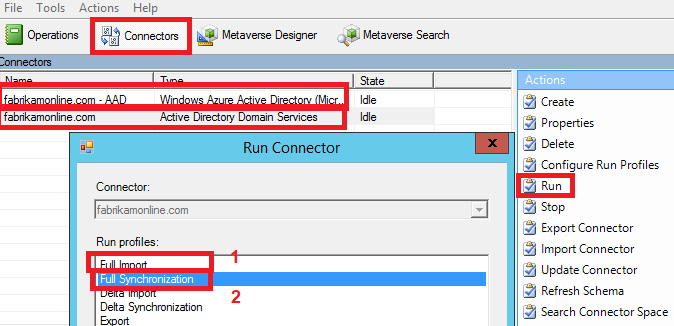Event 130 errors have started appearing in our 2019 Essentials 'Directory Synchronization' log every 30 minutes. I'll post a sample at the bottom.
The referenced 'User Object' is a departed employee. The "User_79888ec3-c003-42f7-8905-f998e769a84c" matches the Object ID of his Shared Mailbox in Azure AD.
We typically delete the local A/D user, restore it in M365 and convert the mailbox to Shared. We did this for the user 2 months ago. Last month, to clean up other errors, I also set the Immutable ID on the Cloud account to "$null".
Synchronization Service Manager shows no errors.
Azure Active Directory Connect Health shows no errors.
Azure AD Connect version (2.0.28.0)
I read this as something on the server is reaching out to contact the cloud version of the user, but failing to find it.
Advice?
Log Name: Application
Source: Directory Synchronization
Date: 2/22/2022 3:49:10 PM
Event ID: 130
Task Category: None
Level: Error
Keywords: Classic
User: N/A
Computer: ServerName.XXX.local
Description:
Get single object failed to get object User_79888ec3-c003-42f7-8905-f998e769a84c. Tracking Id: 00000000-0000-0000-0000-000000000000, Exception: Exception details =>
Type => Microsoft.Online.Coexistence.AzureADObjectNotFoundException
An error occurred. Error Code: 53. Error Description: An internal error has occurred. This operation will be retried during the next synchronization. If the issue persists for more than 24 hours, contact Technical Support. Tracking ID: 2416b89a-feae-4448-b22d-02361cf6c577 Server Name: .
StackTrace =>
at Microsoft.Online.Coexistence.ProvisionHelper.AdminWebServiceFaultHandler(FaultException1 adminwebFault) at Microsoft.Online.Coexistence.ProvisionHelper.InvokeAwsAPI[T](Func1 awsOperation, String opsLabel, IEnumerable`1 operationHeaders)
at Microsoft.Azure.ActiveDirectory.Connector.ProvisioningServiceAdapter.<>c__DisplayClass83_0.<GetSingleObject>b__0()
at Microsoft.Azure.ActiveDirectory.Connector.ProvisioningServiceAdapter.ExecuteWithRetry(String actionName, Action action)
at Microsoft.Azure.ActiveDirectory.Connector.ProvisioningServiceAdapter.GetSingleObject(SyncReference reference, Byte[] singleObjectCookie, Byte[] readbackCookie, Boolean isFullImport, String[] reasons)
at Microsoft.Azure.ActiveDirectory.Connector.GetImportEntriesTask.FullObjectRefetcher.FetchFullAzureADObject(CaseInsensitiveSchema schema, ProvisioningServiceAdapter provisioningServiceAdapter, SyncReference reference, Byte[] originatingReadbackCookie, Boolean isFullImport, String[] reasons)
at Microsoft.Azure.ActiveDirectory.Connector.GetImportEntriesTask.ReadFullRefetchObjects(Byte[] originatingCookie)
InnerException =>
Type => System.ServiceModel.FaultException`1[[Microsoft.Online.Coexistence.Schema.AdminWebServiceFault, Microsoft.Online.Coexistence.Schema.Ex, Version=1.0.0.0, Culture=neutral, PublicKeyToken=31bf3856ad364e35]]
An internal error has occurred. This operation will be retried during the next synchronization. If the issue persists for more than 24 hours, contact Technical Support.
StackTrace =>
Server stack trace:
at System.ServiceModel.Channels.ServiceChannel.HandleReply(ProxyOperationRuntime operation, ProxyRpc& rpc)
at System.ServiceModel.Channels.ServiceChannel.Call(String action, Boolean oneway, ProxyOperationRuntime operation, Object[] ins, Object[] outs, TimeSpan timeout)
at System.ServiceModel.Channels.ServiceChannelProxy.InvokeService(IMethodCallMessage methodCall, ProxyOperationRuntime operation)
at System.ServiceModel.Channels.ServiceChannelProxy.Invoke(IMessage message)
Exception rethrown at [0]:
at System.Runtime.Remoting.Proxies.RealProxy.HandleReturnMessage(IMessage reqMsg, IMessage retMsg)
at System.Runtime.Remoting.Proxies.RealProxy.PrivateInvoke(MessageData& msgData, Int32 type)
at Microsoft.Online.Coexistence.Schema.IProvisioningWebService.GetSingleObject(SyncReference reference, Byte[] singleObjectCookie, Byte[] readbackCookie, Nullable1 isFullReadBack, String[] getSingleObjectReason) at Microsoft.Online.Coexistence.ProvisionHelper.<>c__DisplayClass67_0.<GetSingleObject>b__0() at Microsoft.Online.Coexistence.ProvisionHelper.InvokeAwsApi[T](Func1 awsOperation, String apiAction, String applicationId, Guid clientTrackingId, String clientVersion, String contextId, String dirSyncBuildNumber, String fimBuildNumber, String machineIdentity, IEnumerable1 operationHeaders) at Microsoft.Online.Coexistence.ProvisionHelper.InvokeAwsAPI[T](Func1 awsOperation, String opsLabel, IEnumerable`1 operationHeaders)

